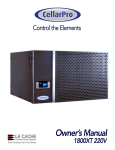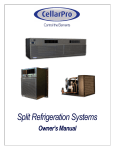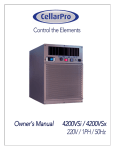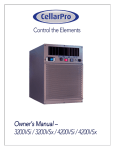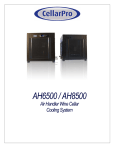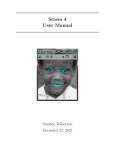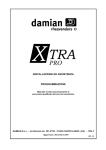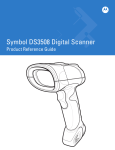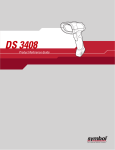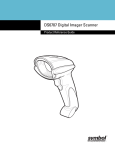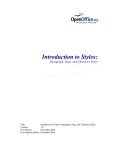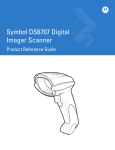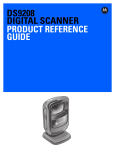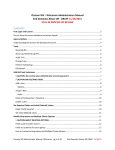Download CellarPro 3000s Owner`s manual
Transcript
Cont r ol t heEl ement s Owner ’ sManual Fi neFur ni t ur ef orFi neWi nes CONGRATULATIONS! Thank you for purchasing a new CellarPro cooling system. Please take a minute to read through this Owner’s Manual before you unpack, install and turn on your Cooling Unit. If you have any questions about your new cooling unit, it is likely that you will find the answers in this Owner’s Manual. We also have more information on our website, including the latest version of the Owner’s Manual, at www.cellarpro.com/customerservice . If you still have questions, please don’t hesitate to contact your dealer or CellarPro directly. We can be reached during normal business hours at 1.877.726.8496. You also may contact us anytime via email at [email protected]. Contact Information: CellarPro Cooling Systems 531 Mercantile Drive Cotati, CA 94931 877.726.8496 Email: [email protected] Website: www.CellarProCoolingSystems.com Serial Number*: ____________________ *We recommend that you take a minute to fill-in your CellarPro serial number above. The serial number has seven-digits and can be found on the printed label on the left side of your cooling unit. Don’t forget to register your cooling unit warranty at www.cellarpro.com/register 1 Table of Contents I. Prior to Installation 4 II. Overview 5 III. Installation Instructions – Wine Cellars 8 IV. Replacement Instructions – Wine Cabinets 14 V. 17 Operating Instructions VI. Troubleshooting 25 VII. Limited Warranty 28 3 I. Prior to Installation Test the unit before installing it. 1. Remove the unit from the box. SAVE THE BOX AND PACKING MATERIALS. 2. Remove any materials that have been packed inside the exhaust cavity 3. Plug in the power cord. The cooling system is programmed with a 3-Minute Delay at Startup to protect its internal components 4. Let the unit run on a hard, flat surface for no more than 10 minutes. 5. Make sure that all fans in the cooling unit are spinning. 6. Check that the cooling unit is discharging cold air from the bottom (it should be approximately 10°F colder than the temperature on the digital display) 7. Turn the unit “off”, install the unit, and wait 24 hours before operating your CellarPro cooling unit. This will protect the unit from internal damage that could arise if the unit was shipped, stored or tilted on its side. Make sure that the exhaust panel is installed in the correct position – it should cover either the TOP or the REAR exhaust vent: o TOP VENT CONFIGURATION: If the hot air will be discharged through the TOP of the cellar, install the exhaust panel on the BACK of the cooling unit (as shown in the Picture A). In this configuration, the cavity on TOP of the cooling unit is OPEN. Picture A Top Vent Configuration o REAR VENT CONFIGURATION: If the hot air will be discharged through the REAR of the cellar, use the exhaust panel to seal the TOP of the cooling unit (as shown in the Picture B). In this configuration, the cavity at the REAR of the CellarPro is OPEN. Picture B Rear Vent Configuration 4 II. Overview CellarPro Cooling Capacity* Estimated thermal loads for various size cellars, with various insulations, various ambient temperatures and various cellar temperatures, are shown in the table below. To figure out whether a CellarPro unit will work in your space, make sure that the cooling unit’s BTUH for a given cellar temperature (at the top of the table) is equal or greater than the thermal load shown in the body of the table. The non-bold, unshaded numbers are within the capacity of all units. The unbold, lightly shaded numbers are within all units except the 1800QTL. The bold numbers are beyond the capacity of the 1800QTL and 1800QT. The italicized numbers are appropriate only for the 1800XTS / XTSx. “X” indicates conditions beyond the capacity of all units. Cellar Temp BTUH 1800QTL BTUH 1800QT BTUH 1800XT BTUH 1800XTS / XTSx Cellar Insulation – Walls, ceiling & floor*: Cellar Size Ambient Temp 75 Degrees 100 Cu Ft. 85 Degrees 95 Degrees 55 Degrees 1065 1380 1456 1886 60 Degrees 1154 1479 1558 2031 R-12 R-19 R-12 R-19 1068 1180 1291 979 1046 1114 940 1038 1136 862 920 980 200 Cu Ft. 75 Degrees 85 Degrees 95 Degrees 1380 1538 1699 1253 1349 1446 1214 1353 1495 1103 1187 1272 300 Cu Ft. 75 Degrees 85 Degrees 95 Degrees 1700 X X 1542 1562 1909 1496 1672 2003 1357 1463 1558 400 Cu Ft. 75 Degrees 85 Degrees 95 Degrees X X X 1744 1879 X 1690 1888 X 1535 1654 1773 *Please note: Glass panels, windows and doors have much lower insulation (at most R-3) and therefore heat loads will increase dramatically when glass is used in cellars. 5 Size & Electrical Specifications Model 1800 QTL/QT/XT/XTS 1800 XTSx Dimensions W” x D” x H” 18 x 16.5 x 10.5 Weight (lbs) 60 Operating Amps 3 Required Circuit 15-Amp Dedicated 18.1 x 22 x 10.6 70 3 15-Amp Dedicated Ambient Environment CellarPro cooling units are designed to operate in ambient temperatures between 45°F and 95°F. Except for the 1800XTSx cooling unit, all cooling units are designed for internal use only, and are not designed for exposure to the exterior. CellarPro cooling units are not designed to generate heat inside the cellar, so if temperatures inside the cellar drop below proper wine storage temperatures, the cooling unit cannot increase the temperature inside the cellar. Proper temperatures are maintained by transferring heat from inside wine cellars and exhausting heat through the top (top-vent) or rear (rear-vent) of the cooling units. Insulation CellarPro cooling units are designed to be installed inside wine cellars that have proper insulation, moisture barriers and an airtight seal from the environment outside the cellar. Interior walls and floor should have a minimum of R-11 insulation, and a vapor barrier on the warm side of the insulation. The ceiling should have a minimum of R-19 insulation and a vapor barrier on the warm side of the insulation. Doors also should be insulated and tightly sealed with weather stripping around the perimeter of the door. Surface-mounted fixtures are recommended over recessed lighting, which can allow air to leak 6 into the cellar. Please note: The R-values above are the MINIMUM recommended amounts of insulation. It is advisable to use as much insulation as possible inside your walls, ceiling and floor. It is critical that all walls, joints, doors and windows, electrical outlets and/or switches, pipes, vents and light fixtures be sealed to prevent air and moisture from entering the cellar. If there is a leak in the cellar, the cooling unit will build up excess condensation that eventually may damage the internal components and shorten the life of the cooling unit, and may cause water to leak from the cooling unit. We offer a Wine Cellar Modification for cooling units that will be installed in wine cellars (as opposed to wine cabinets.) The Wine Cellar Modification provides a fitting and condensate tube at the back of the cooling unit to relieve excess moisture that may condense inside the cooling unit. For installations in warm environments and/or cellars without airtight seals, we strongly recommend this modification. However, the modification does not replace the requirement for a cellar to have proper insulation, moisture barriers and airtight seals from the environment outside the cellar. If your cooling unit has the wine cellar modification, please make sure that the tube has a condensate trap that is slightly filled with water, as follows: As shown above, the drain line should drop, then rise (but stay below the height of the fitting), and then drop again into a drain or bucket. Then, fill the trap with water. The condensate trap will allow any excess moisture inside the cooling unit to overcome the static pressure and flow out of the drain line. Please note: If you do not use a trap, you will see little – if any – condensation, for the same reason that water stays inside a straw when one end is sealed. 7 III. Installation Instructions – Wine Cellars CellarPro cooling units are designed to be installed THROUGH THE WALL. A hole should be cut 1/4 inch larger than the dimensions (W x H) of the cooling unit. Horizontal 2 x 4 inch braces should be installed between the studs below and above the cooling unit. If the studs in the wall must be cut to accommodate the width of the cooling unit, vertical braces also should be installed on either side of the cooling unit. CellarPro cooling units must always be mounted in the upright position and located as close to the ceiling as possible inside the cellar. As warm air rises to the top of the cellar, the cooling unit pulls the warm air through the evaporator coils and removes the heat from the warm air. Once cooled, the cold air is discharged from the bottom of the cooling unit and circulates downward through the cellar. The rear of the cooling unit should be slightly lower than the front of the cooling unit (ie the cooling unit should be tilted backwards slightly), so that excess condensation won’t drip through the evaporator fan cavity. The rear of the cooling unit should be supported by the wall through which it is installed, and should be flush with the wall. Assuming 4 1/2 inch interior wall thickness, the front 12 inches will be inside the cellar. The rear of the cooling unit must be installed in a space that is at least as large as the wine cellar unless the rear intake and exhaust are ducted. The rear of the cooling unit requires a minimum clearance of 8 inches in an open (ie non-enclosed, non-recessed) environment. The front of the cooling unit requires a minimum of 3 inches of clearance inside the cellar, and the bottom of the cooling unit requires clearance of 8 inches below the cold air discharge. The front of the cooling unit can be mounted using optional mounting clips (available for purchase from CellarPro), as follows: 8 Alternatively, the front of the cooling unit can be supported by a shelf and a diagonal brace. The shelf can be up to 13.25” inches wide, and should be positioned on the right side of the cooling unit so that it doesn’t restrict the exhaust vent below the cooling unit, as follows: 9 Once the cooling unit is installed, all cracks and gaps between the cooling unit and the cellar should be sealed. We provide butyl tape (shipped in the cavity of the exhaust vent) for sealing these gaps. The butyl tape is pliable, and is designed to be rolled and stretched in your hands to fit around the entire cooling unit. (If you adhere the tape before rolling and stretching it, you will not have enough tape to complete the job). Pay particular attention to the seams on the back of the cellar (top and rear vent configurations) and the seams at the top of the cellar (top-vent configuration). Ventilation WITHOUT DUCTING Proper ventilation is critically important for the proper operation of your CellarPro cooling unit. The CellarPro cooling unit blows a significant amount of hot air through the top or the rear of the cooling unit, and the hot air must be exhausted into a space that is at least as large as the wine cellar in order for the heat to properly dissipate. If the space is too small or constrained, the heat will not dissipate and the cooling unit will recirculate its own hot air, which will impair the cooling unit’s ability to create cold air inside the cellar. 10 1. Condenser Air Intake (Rear). The condenser coils are located at the rear of the cooling unit. These coils require access to cool air in order for the cooling unit to produce cool air. In general, the cooling unit will be able to produce cold air that is 30°F below the temperature of the condenser air intake. The cooling unit must be installed so that, after its installation, there is access to the condenser coils at the rear of the cooling unit for periodic cleaning of the coils. Minimum clearance of 8 inches is required behind the cooling unit. 2. Condenser Air Exhaust (Rear or Top). Condenser air can be exhausted either through the top or the rear of the cooling unit. CellarPro units have interchangeable vent panels that can be swapped between the top and the rear of the cooling unit to match the configuration of your cellar and exhaust space. Rear vent configuration (most common): in this configuration, the panel is attached to the top of the cooling unit and hot air is freely exhausted from the rear of the cooling unit into the exhaust space, which should have the same space capacity as the wine cellar. (eg, if the cellar is 300 cubic feet, the exhaust space also should be 300 cubic feet.)In addition, this configuration should have 4-6” of unobstructed clearance directly behind the cellar. Top-vent configuration (less common): in this configuration, the panel is attached to the rear of the cooling unit and hot air is freely exhausted from the top of the cooling unit into the exhaust space. If the exhaust space is shared with the rear of the cooling unit, it should have the same space capacity as the wine cellar (eg, if the cellar is 300 cubic feet, the exhaust space also should be 300 cubic feet.). WITH DUCTING We offer a duct kit that is designed to work with all CellarPro 1800 cooling units. The kit includes: A duct hood that fits over the rear of the cooling unit and is designed to connect to two 6” ducts (one for intake and one for exhaust), with a removable slot for changing air filters; A 6” inline fan, plus wiring from the cooling unit that provides switched power to the fan (the cooling unit cannot be ducted without an inline fan). When connecting the fan to our switched power line, please follow local building codes, which may require the use of conduit for the wiring and junction boxes for any wire connections. The fan can be installed anywhere in the ducting – either on the intake side or the exhaust side, and either at the beginning or the end of the ducting. 50’ (2 x 25’) of insulated 6” ducting. 11 With our duct kit, CellarPro 1800 cooling units can be ducted up to 50 equivalent feet per duct. When calculating equivalent feet, each 90 degree turn in the ducting approximately equals 8’ of ducting. Be sure to use gradual turns to avoid restricting airflow inside the ducting. Consult your HVAC professional for further information. INSIDE THE CELLAR CellarPro cooling units are designed to turn on when the temperature near the ceiling inside the cellar exceeds the Minimum Set Point plus the Temperature Differential, and turn off when the temperature inside the cellar drops below the Minimum Set Point. The Minimum Set Point and Temperature Differential can be set according to instructions in the following Chapter. For example, if the Minimum Set Point is 58°F and the Temperature Differential is 4°F, the cooling unit will turn on when the temperature inside the cellar rises above 62°F, and turn off when the temperature falls below 58°F. In this example, the cellar temperature will average 60°F. 1. Evaporator Air Intake. The evaporator coils are located on the face of the cooling unit behind the grill. CellarPro cooling units are designed to be mounted at the highest point inside wine cellars, so that warm air – which rises – will be the first to pass over the evaporator coils, which will remove the heat from the air. To ensure proper airflow, a minimum of 3” of clearance is required in front of the cooling unit. 2. Evaporator Air Exhaust. Cold air is exhausted through the bottom of the cooling unit. Because CellarPro cooling units are located at the highest point inside wine cellars, the cold air will fall to the bottom of the cellar. To ensure proper airflow and reduce temperature stratification inside the cellar, the space below the cold air discharge should be clear of any obstructions, including wine bottles, wine racks, etc. Power Requirement CellarPro 1800 cooling systems require a dedicated 15-amp circuit. We recommend using a surge protector to protect the internal components in case of a power surge. The cooling unit uses approximately 3 amps during its “on” cycle. The cooling unit also offers a grounded 115V AC outlet, which is rated for 3 amps. A number of variables, including the minimum set point, the temperature in the ambient environment, the insulation of the cellar, and the thermal mass inside the cellar, will affect the cooling unit’s runtime. It is normal for the cooling unit to run up to 75 percent of the time in order to maintain proper conditions inside the cellar. 12 Summary Keep in mind the following guidelines before purchasing a wine cooling unit from CellarPro: If the cellar it too large for the cooling unit, and/or if the cellar does not have adequate insulation, the cooling unit will be unable to maintain proper temperatures throughout the cellar. Without a moisture barrier and an airtight environment inside the cellar, the cooling unit effectively will become a de-humidifier and may produce buckets of water. The rear of the cooling unit must be installed in a space that is at least as large as the wine cellar unless the rear intake and exhaust are ducted. Both the front and the rear of the cooling unit require a minimum clearance of 8 inches. The cooling unit needs to have access to fresh, cool air at the rear of the cooling unit. Without fresh, cool air, either because of improper ventilation or environments that are too hot, the cooling unit will be unable to maintain proper temperatures inside the cellar and the HA2 alarm will be triggered. CellarPro 1800 cooling units require a dedicated 15-amp circuit Under these conditions, the unit’s internal components may become damaged, the expected useful life of the wine cooling unit may be adversely affected, and the product’s warranty may become null and void. 13 IV. Replacement Instructions A. Replacement Instructions TOOLS NEEDED: Phillips screwdriver 7/16" open end wrench or socket Needlenose pliers REQUIRED PARTS Replacement Cooling Unit Butyl Sealant Tape REMOVAL OF OLD COOLING UNIT: 1. Unplug the cooling unit from the wall. FROM THE TOP OF THE CELLAR 2. If your cellar comes with a grill(s), remove and discard the grill(s) on top of the cellar. You do not need a grill with the CellarPro cooling unit. 3. Pull the power cord through the back of the cellar. 4. Note the location where sealant is applied to maintain an airtight seal inside the cellar. FROM THE FRONT OF THE CELLAR 5. Open cabinet door and remove all bottles from the top of the rack. 6. Place a heavy towel or blanket on top of the wine rack for protection. 7. IF YOU HAVE A LE CACHE MODEL 2400 WITH A CENTER POST: Remove the center post by unscrewing the screws (two at the top and two at the bottom) that attach the post to the wine cabinet. 8. Unplug the light from the cooling unit inside the cellar, and also unplug the cord from the light fixture. 9. Remove the light fixture as follows: - Slide the light left or right, and then unscrew and remove one of the two mounting brackets that attach the light fixture to the ceiling of the cellar. 14 - Slide the light fixture off the second mounting bracket. 10. With 7/16 socket wrench, remove the two hex head bolts that attach the cooling unit to the ceiling of the cellar. Save these bolts! Leave mounting brackets attached to the cooling unit so that the proper location can be duplicated with the replacement cooling unit. PLEASE NOTE: If the nut in the ceiling becomes loose, you will need to use pliers from the top of the cabinet to hold the nut and keep it from spinning with the bolt. 11. The cooling unit is now free to remove. Drop front end down, and move side to side to free from cabinet opening. CAUTION: Two people may be required to remove the cooling unit, which weighs 58 pounds. Do not let the cooling unit drop on unprotected bottle racks. TO INSTALL THE REPLACEMENT COOLING UNIT 1. Carefully remove the replacement cooling unit from the packaging. NEVER store the cooling unit upside down or on its side, and NEVER turn the unit upside down. You may reuse this packaging for shipping or storing the old cooling unit 2. Remove any materials that have been packed inside the exhaust cavity. 3. Before installing the cooling unit, make sure it works by plugging it in and letting it run on a hard, flat surface for no more than 5 minutes. Check that cold air is being produced by the unit. PLEASE NOTE: CellarPro cooling systems are programmed with a 3-minute delay at start-up to protect its internal components. 4. For top-vent configurations, make sure that the exhaust panel is installed at the REAR of the cooling unit, so that the top of the unit has an opening for the hot air exhaust. For rear-vent configurations, make sure that the exhaust panel is installed in the TOP of the cooling unit, so that the rear of the unit has an opening for the hot air exhaust. In both configurations, return air from outside the cellar will come into the coils at the rear of the cooling unit. 5. If using mounting clips, attach the clips to the FRONT of the cooling unit so that the short side slides under the metal fold near the top of the cooling unit, and space the clips so that they’ll line up with the holes in the ceiling of the cellar. You may need to remove the front grill (attached with two screws on each side of the cooling unit) in order to slide the mounting clips under the sheet metal, then replace the front grill after the clips are in place. 15 6. If your wine cabinet has three pieces of foam located on the bottom and on each side of the black metal bracket that supports the rear of the cooling unit (attached to the rear wall in most top-vented units), place these foam pieces along the bottom and sides of the metal bracket. 7. Install the cooling unit by following the removal instructions described above in reverse. 8. A complete and proper seal must be made between the cellar and the cooling unit to ensure that outside air does not enter the cellar. Use butyl adhesive tape to seal the perimeter where the cooling unit touches the cellar by rolling the tape with your fingers into a thin (pencil diameter) "rope", then press the tape into the cracks where the cooling unit touches the cellar. 9. Check the seal by having a helper stand in front of the cabinet while you shine a flashlight around the cooling unit edges to discover any gaps in sealant. 10. Wait 24-hours before running the cooling unit. We recommend plugging the cooling unit into an outlet with a dedicated 15-amp circuit and a surge protector. RETURNING THE ORIGINAL COOLING UNIT: If the original cooling unit is under warranty and you are returning it, please follow the instructions below: 1. Use the original packaging to repack the cooling unit. 2. Make sure that the cooling unit is upright in the box 3. The exterior of the box should be prominently marked with “This Side Up” and “Fragile” for the freight carrier 16 V. Operating Instructions Overview Please follow the instructions in Chapter I prior to turning on your CellarPro cooling unit. CellarPro cooling units are designed to maintain optimal conditions for wine storage and aging. These conditions include steady, cool temperatures, high humidity, minimal vibration and light, and clean air. The settings on your CellarPro cooling unit have been preset and optimized by the factory. Before changing any settings below, we recommend waiting 14 days to allow the cooling unit to “break in.” The cooling unit is designed to cool the cellar gently without stripping moisture out of the cellar environment. Therefore, it is not uncommon for the cooling unit to run nonstop for up to a week initially, depending on the temperature inside the cellar, the size of the cellar, and the temperature of the ambient environment. Once the cellar has reached equilibrium, it is normal for the cooling unit to run as much as 75 percent of the time. CellarPro cooling units are designed to maintain optimal temperatures for storing and aging fine wine. CellarPro cooling units are not designed to maintain temperatures for serving wine, which tend to be much colder than storage temperatures, especially serving temperatures for white and sparkling wines. CellarPro cooling units must be used, stored, moved and/or shipped in the upright position. Be careful when turning the unit on its side. The unit NEVER should be turned upside down. Bottle Probe Bottle probe temperature sensors can be used to cycle on/off based on changes in air or liquid temperatures inside the wine cellar. When used to measure liquid temperatures, our bottle probe, which includes a rubber bottle stopper to avoid leaks and spills, should be inserted into a wine bottle filled with water and alcohol to avoid bacteria growth. The 10-foot cord allows the bottle to be placed almost anywhere inside the wine cellar. The other side of the probe is fitted with a jack that plugs directly into the wine cooling unit. When using a bottle probe to measure liquid temperature, we recommend reducing the temperature (HY) differential from 4 degrees to 1 degree. Refer to our “Advanced Operation” instructions for further instructions how to change the HY differential. 17 Basic Operation The temperature inside the cellar can be increased or decreased by changing the Minimum Set Point as described later in this chapter. If the cooling unit runs too much, you can raise the Minimum Set Point to reduce the cycle “on” time. Most wine collectors store their wine in the range of 55 - 60°F. CellarPro cooling units are designed to maintain appropriate levels of humidity, ranging from 50 to 70 percent, inside wine cellars. In order to increase or decrease humidity inside the cellar, the Fon setting can be changed as described in the “Advanced Operation” section later in this chapter. Digital Display The temperature displayed on the control indicates the real-time air temperature as measured by Probe 1 (P1) located behind the front grill of the cooling unit, or the temperature (air or liquid) being measured by the bottle probe (the bottle probe overrides P1). 18 Power On/Off Button Press “Power On/Off” to turn the unit on and off When the “Compressor On” indicator light is on, the Compressor is running. When the “Fan On” indicator light is on, the Fan is running Up and Down Buttons To view the “High Temp” recorded by the cooling unit, press the “Up” button once. To view the “Low Temp” recorded by the cooling unit, press the “Down” button once To reset the “High Temp” or “Low Temp”, press the “Set” button for three seconds while “Hi” or “Lo” is displayed. “RST” will blink three times to indicate confirmation. Set Button The cooling unit is factory preset with a Minimum Set Point of 58°F and a Temperature Differential of 4°F. This means that the cooling unit will turn on when the display rises above 62°F (58°F + 4°F), and turn off when the display falls below 58°F. In this example, the average temperature inside the cellar will be 60°F. To view the Minimum Set Point, press the “Set” button for one second. To change the Minimum Set Point, 1. Press the “Set” button for three seconds until “°F” blinks 2. Press the “Up” or “Down” button 3. Press the “Set” button to confirm The “Set” temperature will blink three times to indicate confirmation. The recommended Minimum Set Point range is 53 - 60°F. To change the Temperature Differential, see “Advanced Operation” later in this chapter. 19 Energy Saver Button To activate and deactivate the “Energy Saver” mode, press the “Energy Saver” button The “Energy Saver” indicator light will turn on when the cooling unit is in “Energy Saver” mode In “Energy Saver” mode, the Minimum Set Point increases 4°F and the Temperature Differential is unchanged Quick Chill Button To activate the “Quick Chill” mode, press the “Up” / “Quick Chill” button for three seconds To deactivate “Quick Chill”, press “Quick Chill” button for three seconds again The “Quick Chill” indicator light will turn on when the cooling unit is in “Quick Chill” mode In the “Quick Chill” mode, the cooling unit will run continuously for 6 hours (or until the intake temperature registers 50°F). This mode is useful after loading “warm” bottles in a cellar AIR FILTER We offer an optional air filter that magnetically attaches to the rear of the cooling unit. To replace the filter, remove the filter frame from the cooling unit (see the image at right), and replace the filter when it becomes dirty (anywhere from 3 to 9 months depending on the conditions in your location. When replacing the filter, the blue fibers should face the cooling unit, and the white fibers should face away from the cooling unit. Replacement filters may be purchased at www.cellarpro.com. 20 Remote Control / Display Instructions Digital Display The temperature displayed on the control is red instead of blue. Quick Chill Button To activate the “Quick Chill” mode, press the “Up” button for three seconds Button Icon To deactivate “Quick Chill”, press the “Up” button for three seconds again The “Quick Chill” indicator (Row 3) light will turn on when the cooling unit is in “Quick Chill” mode, In the “Quick Chill” mode, the cooling unit will run continuously for 6 hours (or until the unit reaches set point.). This mode is useful after loading “warm” bottles in the cabinet. Auto Defrost Mode The cooling unit has a factory default defrost cycle that initiates every 16 hours for 20 minutes. When the cooling unit is in auto-defrost mode, the “Defrost” Indicator light (Top row) will turn on, and the evaporator fan will run. Manual Defrost Hold the defrost button in for 3 seconds to initiate a manual defrost. The “Defrost” Indicator light (Top row) will turn on for a 20 minute defrost cycle. Light The light button function is disabled, however pressing it will turn on/off the light indicator on the display (2nd row). Energy Saver The remote display is not configured with an Energy Saver mode. The set point can be raised manually for periods where energy savings is desired. 21 Advanced Operation CellarPro cooling systems can be programmed with advanced settings to achieve more control over conditions inside the cellar. Conditions like humidity, the Temperature Differential, and alarm settings all can be modified for custom applications. To access the advanced settings, do the following: Press the “Set” button and the “Down” button together at the same time, and hold for three seconds. Then, use the “Up” or “Down” button to scroll to the following screen: HUMIDITY: The factory preset for this setting is “3”. If the humidity inside the cellar is too low, press the “Set” button, then use the “Up” button until the desired setting is reached. The recommended range for this setting is 0-6. TEMPERATURE DIFFERENTIAL: The factory preset for this setting is “4” without a bottle probe, and “1” with a probe. When added to the set point, this setting determines the temperature at which the cooling unit will cycle on. The recommended range for this setting is 4 or 5 unless using a bottle probe in liquid, in which case the recommended setting is 1. HIGH TEMPERATURE ALARM: setting is “70”. The factory preset for this This setting designates the High temperature inside the cellar at which the alarm is triggered. We recommend leaving this setting at the factory preset. LOW TEMPERATURE ALARM: The factory preset for this setting is “45”. This setting designates the Low temperature inside the cellar at which the alarm is triggered. We recommend leaving this setting at the factory preset. ENERGY SAVINGS MODE DIFFERENTIAL: The factory preset for this setting is “4”. This setting increases or decreases the Temperature Differential for the Energy Savings Mode. The recommended range for this setting is 2-4. 22 Standard Protection Mechanisms The cooling unit is programmed to shut down certain components to protect those components, as well as the wine inside the cellar, under the following circumstances: Scenario What it means What happens P1 Alarm Probe 1, which senses the temperature inside the cellar and controls the on/off cycles of the cooling unit, has failed The cooling unit enters a timed auto-cycle mode until Probe 1 is repaired or replaced. In this mode, the cooling unit will turn for 12 minutes and off for 8 minutes. Optional Protection Mechanisms CellarPro cooling systems can be programmed to turn off the compressor and condenser fan in the event of an HA2 alarm, as described below. If you’d like to turn on this protection mechanism, please call us toll-free at 877.726.8496 P3 > 140°F for more The condenser probe is measuring than 2 hours temperatures that are too hot The compressor and condenser fan will turn off until the condenser temperature falls below 140°F Maintenance The condenser coils at the back of the cooling unit will collect dust, dirt and lint over time. It is critically important to clean the coils periodically. If the condenser coils become clogged, the cooling unit will not have proper airflow and its performance and longevity will be compromised. To clean the coils, simply vacuum or brush the coils until all dust and lint have been removed. Do not use compressed air to clean the coils because it may force dirt particles into the cooling system and cause serious damage to its internal components. 23 Alarms The cooling unit has both an audible notification and a visual alarm indicator (shown in “red” on the control panel) that are activated when an alarm is triggered. Please note: the HA and LA alarms are disabled during the first 23 hours of operation after the cooling unit is plugged in and/or turned on. The control panel also will flash a code for each alarm, as follows: Alarm Code What it means What to do P1, P3 Probe Failure Call CellarPro at 877.726.8496 HA The temperature inside the cellar is too warm (above 70°F for more than 1 hour) Check seals; HA2 The condenser temperature is too high (above 140°F for 2 hours) Check if door was left open; Lower the ambient temperatures Check for appropriate installation, ventilation, ambient conditions and cooling capacity (Chapter II) Clean the condenser coils (see “Maintenance” in Chapter IV); Check for obstructions to the intake and/or exhaust vents; Check that the condenser fan is operating LA The temperature inside the cellar is too cold (below 45°F) Raise the ambient temperature; Raise the “Minimum Set Point” LA2 The temperature at the condenser coils (outside the cabinet) has dropped below the alarm temperature setting Call CellarPro at 877.726.8496 24 VI. Troubleshooting The Cooling Unit Runs Constantly The cooling capacity of the cooling unit depends on the thermal load on the wine cellar, and the resulting BTU that is required to cool and maintain the cellar at the desired temperature. The cooling capacities of both units are shown on page 2. If the thermal load exceeds the capacity of the cooling unit, you will need to add insulation and/or raise the setpoint on the cooling unit. The cooling unit is designed to turn on when the air temperature in the cellar rises ABOVE the Minimum Set Point + Temperature Differential, and turn off when the air temperature falls below the Minimum Set Point. For example, if the Minimum Set Point is 58°F and the Temperature Differential is 4°F, the cooling unit will turn on above 62°F and turn off below 58°F. In this example, the average temperature inside the cellar will be 60°F. When bottles are first loaded in the cellar, the cooling unit will run continuously (even up to a week) until the temperature inside the cellar falls below the Set Point. After the temperatures inside the wine cellar reach equilibrium, the cooling unit will run anywhere from 30 to 50 minutes in a given hour, depending on the thermal load and the setpoint. Hot weather conditions, insufficient insulation, inadequate ventilation, missized cellar capacity and/or dirty condenser coils can all cause the cooling unit to run continuously. If your CellarPro wine cooling unit runs constantly, try the following: Clean the condenser coils or, if using a filter, replace it with a clean filter Make sure that all the fans are spinning in the cooling unit If the cooling unit is ducted: o Make sure the ducts aren’t kinked o Remove any louvered grills Make sure that the cooling unit is NOT in Energy-Saver Mode Increase the supply of cool air to the space outside the condenser coils (at the rear of the cooling unit) using a fan, exhaust system or ducting Raise the Minimum Set Point on the cooling unit If you continue to have problems, please complete our Cooling Unit Troubleshooting Inquiry Form ((found online) and we'll respond by the next business day. 25 The Cooling Unit Won’t Turn On. The cooling system is programmed with a 3-Minute Delay at Startup to protect its internal components. The HA2 Alarm has been triggered The cooling unit is designed to measure the temperature of the condenser coils and, if the temperature exceeds 140°F for more than 2 hours, the HA2 alarm will display on the control panel. If this alarm happens when you first receive and start operating your CellarPro cooling unit, check for appropriate installation and ventilation (Chapter II). Also, make sure that there aren’t any obstructions to the intake and/or exhaust vents. If your wine cabinet has a grill, remove the grill and/or any other obstructions above (top vent) or behind (back vent) the cellar. If the alarm happens in conjunction with hot ambient conditions, we recommend doing the following: 1. Raise the Minimum Set Point to 60°F until temperatures cool down 2. Increase the Fon setting If the cooling has been operating for several months without any problems and the alarm happens “out of the blue”, check the condenser coils and clean if necessary. If the HA2 alarm continues to be triggered, contact us at 1.877.726.8496 for further assistance. The Cooling Unit Is Dripping The cooling unit is designed to remove excess moisture from inside the cellar, which collects in the drip pan of the cooling unit. Excess moisture can occur when the cooling unit runs constantly, when the Minimum Set Point is too low and/or when the cellar doesn’t have a good seal from the outside environment. To eliminate overflow in the drip pan, do the following: 1. Raise the Minimum Set Point of the cooling unit to 58 degrees or above. 2. Make sure the cellar has good seals, especially at the door(s), and repair any leaks immediately. 3. If the unit is ducted at the front, make sure the ducting is tight against the face of the cooling unit and well-sealed. 26 4. If your wine cooling unit came with a condensate fitting and drain line, make sure you properly setup the condensate trap (Chapter II). If the cooling unit continues to drip, contact us at 1.877.726.8496 for further assistance. The LA2 Alarm has been triggered The cooling unit is designed to measure the temperature of the condenser coils and, if the temperature drops below a certain point, the LA2 alarm will display on the control panel. If you are getting an LA2 alarm, please contact us at at 1.877.726.8496 for further assistance. 27 VII. Limited Warranty 1800 QTL / QT / XT / XTS: For five years from the date of original delivery, your CellarPro warranty covers all parts and labor to repair or replace any components that prove to be defective in materials or workmanship in the cooling unit. 1800XTSx: For five years from the date of original delivery, your CellarPro warranty covers the internal compressor if it proves to be defective in materials or workmanship. In addition, for two years from the date of purchase, your CellarPro warranty covers all parts and labor to repair or replace any components that prove to be defective in materials or workmanship in the cooling unit. Under the terms of this warranty, CellarPro will repair or replace the original cooling unit with a new or refurbished cooling unit and, once replaced, the original cooling unit must be returned to CellarPro. All service provided by CellarPro under the above warranty must be performed by a designated repair center, unless otherwise specified by CellarPro. Purchaser is responsible for shipping the cooling unit to and from CellarPro or to and from a designated repair facility, and for removing and reinstalling the cooling unit from the wine cellar. The limited warranty applies only to cooling units purchased from the factory or an authorized dealer. Damage caused by others or by any cause beyond the control of CellarPro, shall not be considered defects in material or workmanship and is not covered by the warranty. The limited warranty does not cover any parts or labor to correct any defect caused by negligence, commercial use, accident, or improper use, maintenance, installation, service or repair. THE REMEDIES DESCRIBED ABOVE FOR EACH WARRANTY ARE THE ONLY ONES, WHICH CELLARPRO WILL PROVIDE, EITHER UNDER THESE WARRANTIES OR UNDER ANY WARRANTY ARISING BY OPERATION OF LAW. CELLARPRO WILL NOT BE RESPONSIBLE FOR ANY CONSEQUENTIAL OR INCIDENTAL DAMAGES ARISING FROM THE BREACH OF THESE WARRANTIES OR ANY OTHER WARRANTIES, WHETHER EXPRESS, IMPLIED OR STATUTORY. Some states do not allow the exclusion or limitation of incidental or consequential damages, so the above limitation or exclusion may not apply to you. This warranty gives you specific legal rights and you may also have other legal rights, which vary from state to state. To receive parts and/or service and the name of a CellarPro designated repair facility nearest you, contact your CellarPro dealer. You may also contact CellarPro directly by calling us at 1.877.726.8496. 28




























